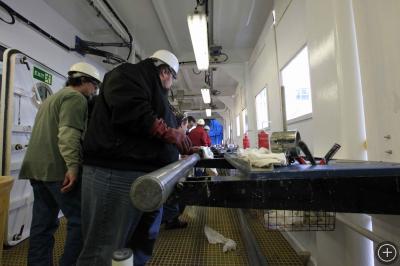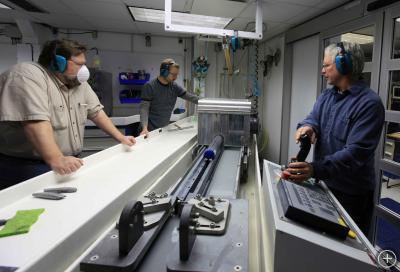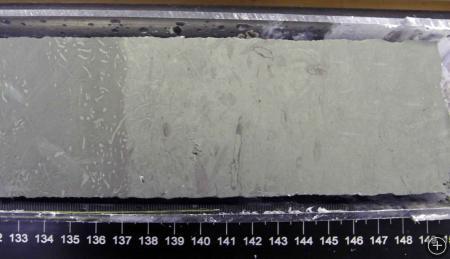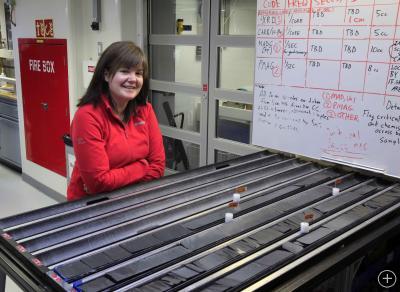Seeing into the Past
Temperature -1C, wind 25 kts, 3 meter swells
At Site U1356, Hole U1356A,
Position: 63º 18.6139’S, 135º 59.9397’E
Water Depth: 4003 meters
ABOARD THE JOIDES RESOLUTION, OFF THE COAST OF WILKES LAND, ANTARCTICA– Here we are on the 29th of January, 20 days out of Wellington, New Zealand, and exactly 1/3 of the way through our expedition to the coast of Antarctica. It’s been a fantastic week for everyone aboard. We have now drilled over 750 meters into the seabed off of the Wilkes Land Coast of Antarctica. We are operating far enough offshore that we are in deep water – over 4,000 meters deep. This means that we have 4750 meters of drill pipe hanging from beneath the ship. The entire length of pipe rotates a drill bit and we bring up sediment cores in 10 m sections about every two hours.

Core on deck – 8AM on Jan 29 2010. This core is from 750 meters below the seafloor and will be worked on for the next 10 hours by the shipboard technicians and scientists.

Cutting the Core from IODP Expedition 318 Site 1356 in Antarctica. This core contains rocks about 25 million years old.
The cores get run through a variety of tests on the ship. We measure how much magnetism they have and how much natural radiation they emit (all rocks and minerals on Earth emit very low levels of natural radiation). This tells us how old the cores might be. We then split them using a diamond saw (we are so deep it is real rock coming up now) and run more tests.

Core from 730 meters beneath the seafloor. It’s hard rock but used to be mud that fell down on the seabed 25 million years ago. There is about 7 meters of sediment here.
I am a specialist in sedimentology which means that I describe the sediment – is it mud? Sand? Does it have fossils? Are there features that tell us of past submarine landslides? The sedimentologists get to see all of the sediment cores that come up so it is very exciting. We have seen long intervals when icebergs were dropping off bits of the Antarctic continent as they floated by and melted. We’ve also seen periods when there wasn’t much ice at all.

A close up view of some of the rock we are collecting. Here you can see ancient worm burrows from small animals that lived that the seafloor. The sediment changes color when the oxygen content of the deep sea changes.

Another section of the core. These stones fell out of icebergs that melted and dropped to the seafloor. The scale is in centimeters.

Cathy Stickley, one of our micropaleontologists who tell us how old the rocks are. She is English but lives now in Norway.
The sediment core that just came up 10 minutes ago (photos above) contains sediments that are something like 20 to 30 million years old. We won’t know for sure until our micropaleontologists have a look but we are approaching a horizon beneath the seafloor where we expect to start seeing evidence that it was much warmer here – maybe 10 to 15 degree centigrade warmer than it is now and a time of no or little ice on Antarctica. We should be done drilling here in 2 more days. Then it’s on to the next site. I’ll keep you posted!










wow so very cool.